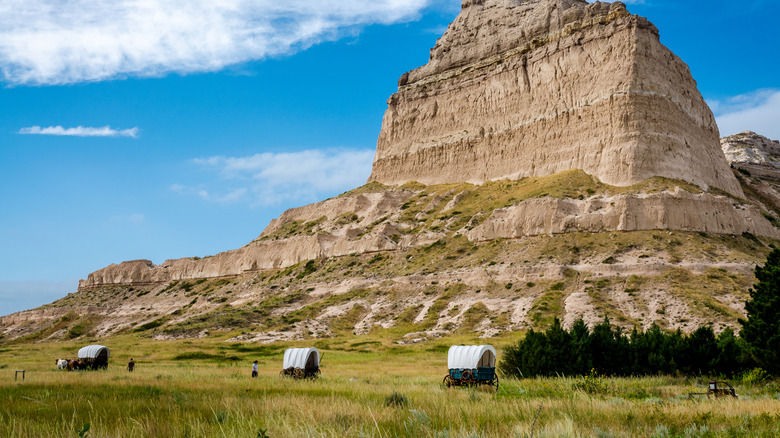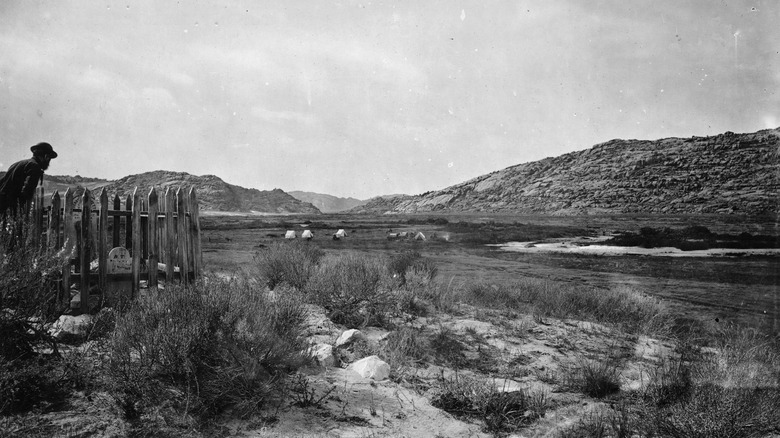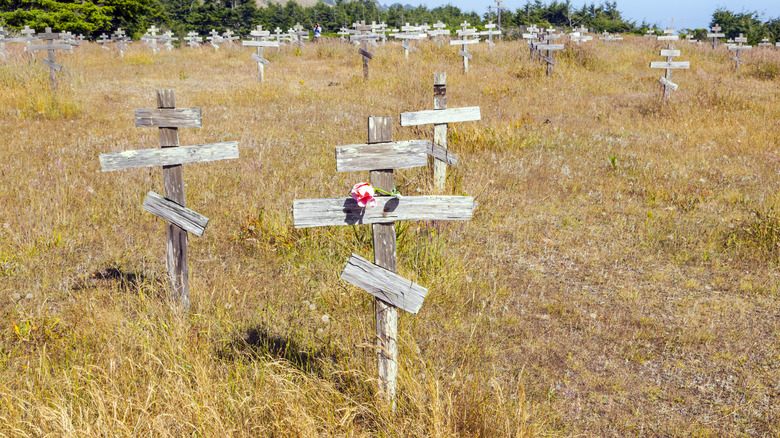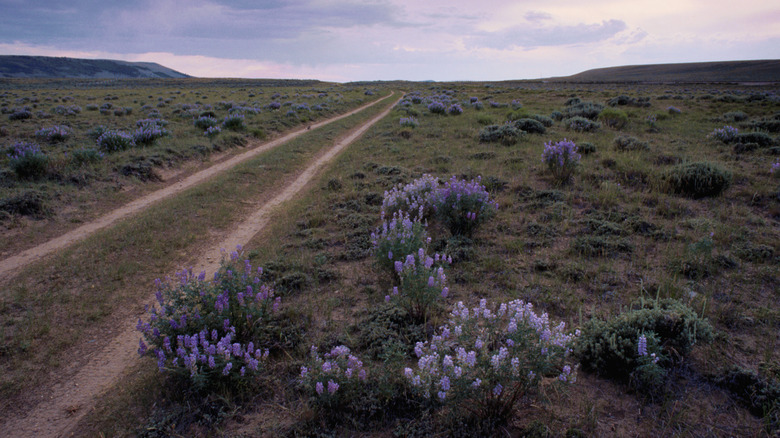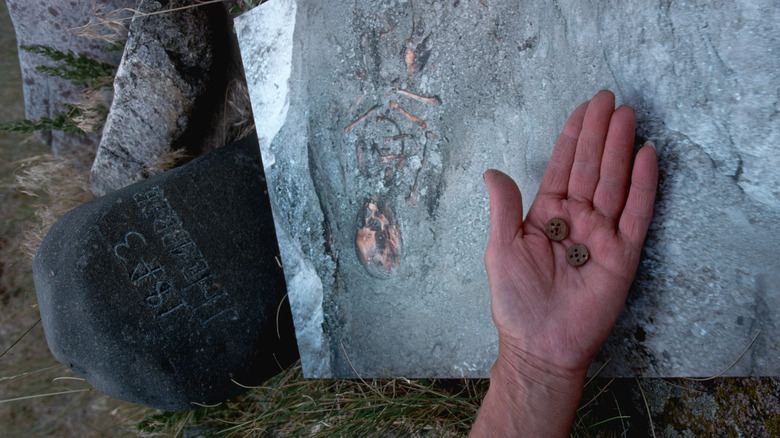What Happened To The Bodies From The Oregon Trail?
At this point, it's well-known how treacherous, lethal, disgusting, and exhausting life was on the Oregon Trail. From 1841 to 1884, about 300,000 to 500,000 pioneers trundled westward across the sedge-and-dust-filled American west in the hopes of, well ... eventually just in the hopes of not dying on the way. Odds are you would suffer mightily along the Oregon Trail, if not meet your end. Disease was absolutely rampant because of unhygienic conditions and included typhoid fever, cholera, tuberculosis, etc. In fact, about 10 to 15 people died every mile on the way, putting the total death toll at 20,000 to 30,000.
If so many people died along the trail, the question begs: What happened to them all? Were the dead just left where they fell? Were bodies buried ad hoc using whatever materials were laying around? Were there any mass graves? Were any graves permanent, or just temporary? The real answer is: All of the above.
As The New York Times outlines, you can envision the Oregon Trail as one long graveyard stretching from the banks of the Missouri River in Independence, Missouri all the way to the western edge of Oregon. While numbers aren't incredibly clear cut, the outlet says one grave every 80 yards along the entire trail is a decent estimate. Graves were often shallow, dug quickly right on the trail, and then ran over with wagon wheels so scavengers wouldn't pick at the bodies. Some pioneers might have even been buried alive.
Quick and shallow burials
It isn't hard to imagine how a typical, individual burial on the Oregon Trail would've gone down. Everyone is exhausted but needs to keep moving unless they want to die when winter hits. Survival supplies are scarce, shelter is limited, and scavengers will sniff out the dead in no time. There are no priests hanging around, so there's no one to deliver strict death rites of the Christian variety. So you dig a shallow grave and place the dead inside — perhaps a husband, sister, son, friend, probably unwrapped and definitely without a coffin. You pack the grave over with gravel and loose earth, say a couple words, and maybe shed some tears if you've got the energy.
From here, as we mentioned, wagons roll over the grave to flatten it and make it harder for predators to dig up the dead. There might be a cross hammered into the earth or nothing at all to prevent thieves from finding the grave and desecrating it. Then, everyone moves on and leaves the deceased behind in the ground until the wagons roll out of sight of the burial site. It's important to remember that at this point, people didn't ride wagons along the trail. They walked, and did so at a pace of about 15 miles per day. Ultimately, the Oregon Trail is indeed America's "longest graveyard," as the Oregon-California Trails Association puts it.
Mass graves for the sick and the slaughtered
While many people along the Oregon Trail died one by one, others died all at the same time. We mentioned diseases like typhoid fever and tuberculosis, which spread like wildfire amongst settlers on the route. Cholera was not only the most deadly disease on the trail, but the most deadly killer overall. Spread via contaminated water that ran from latrines dug into the ground, it caused a whole host of debilitating symptoms that basically resulted in death by diarrhea. It's not an exaggeration to say that those on the trail faced true epidemics rather than a mere rash of illnesses. Such individuals were often buried in mass graves rather than individual graves. Like individual graves, these graves were left anonymous to protect from thieves.
Settlers also buried mass graves for those killed in violent confrontations with Native Americans, which numbered far less than other causes of death but still equaled 362 total people. Most of the time pioneers and natives got along just fine, and they even traded to help each other out. One particular stretch of the Oregon Trail, though, proved lethal when it came to meeting tribespeople. The National Oregon/California Trail Center says that 90% of pioneers killed by Native Americans died west of the trail's South Pass in Wyoming. If enough people died at once in such attacks, they were likely buried in mass graves.
Eaten, abandoned, or buried alive
While it would be comforting to imagine that all of those who died on the Oregon Trail received some sort of proper burial, that's not the case. Resources were so thin that sometimes sick people got left behind. Oregon Trail 101 says that "watchers" might have stayed with the dying — might have, mind you — until someone perished before burying them and catching up to the group. But, time constraints and subpar medical knowledge being what they were, it isn't hard to see how some people might have been buried alive if they were close enough to dying but not obviously dead. Or, they might have even been buried alive intentionally if a watcher was desperate enough to leave. And if pioneers were captured and tortured by Native Americans — as was the case for one Shoshone incident — who's to say what happened to their bodies?
Another even worse fate awaited some of those who died on the Oregon Trail. As people succumbed to starvation, mental illness, and traveled through fields littered with the corpses of dead cattle that themselves had also died of starvation, some pioneers opted for a choice considered almost universally abhorrent: eating the dead. The Oregon-California Trails Association describes at least one incident involving the Donner-Reed Party of 1846 — one group of many — that saw 35 of their members die. When stuck in an unexpected snowstorm, the remaining 47 members ate the dead.
Posing for death
There's one final fate that awaited those who died on the Oregon Trail, one that mirrored the norms of the time: being photographed. Death photography was a huge industry in the 19th century, particularly in Victorian England (1837 to 1901). Despite sounding morbid to us moderns, it makes sense that in an era of limited photography, literacy, and methods to keep the memory of the dead alive, a simple portrait might be the only memento someone has of a deceased loved one.
Despite the anonymity of many of the graves along the Oregon Trail, some of them are marked and identifiable even today. The Oregon-California Trails Association has a list of known and named buried individuals along with their general location. Some graves are on private property, some on public property where they can be visited. We've even got details about these individuals that bring them to life, like Ada Magill, a 3-year-old who died of dysentery and was buried in a "Sunday best tiny calico dress" on July 3, 1864. In 1912, Ada was moved from her original burial location to accommodate the building of a highway (not too far — just 30 feet). The Wyoming Historical Society also has a list of known gravesites along the Oregon Trail within its state borders, some of which overlap with the previous list and all of which have their own individual story.
If you're still curious and have the stomach for it, here are the worst ways to die on the Oregon Trail.
